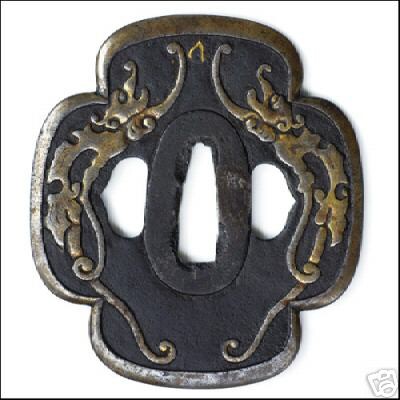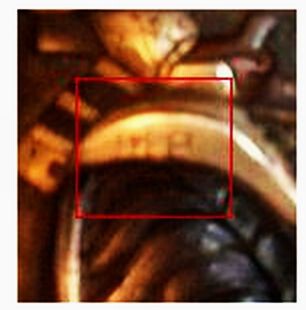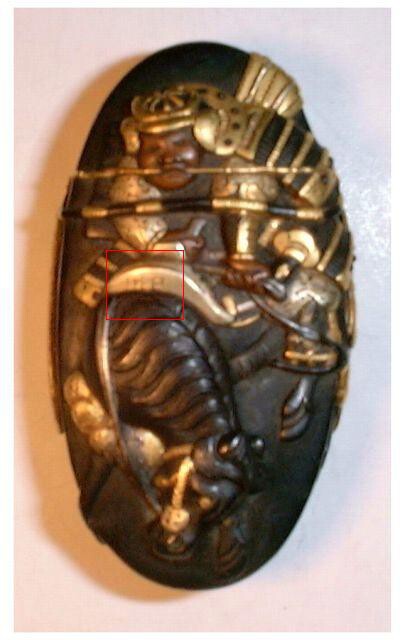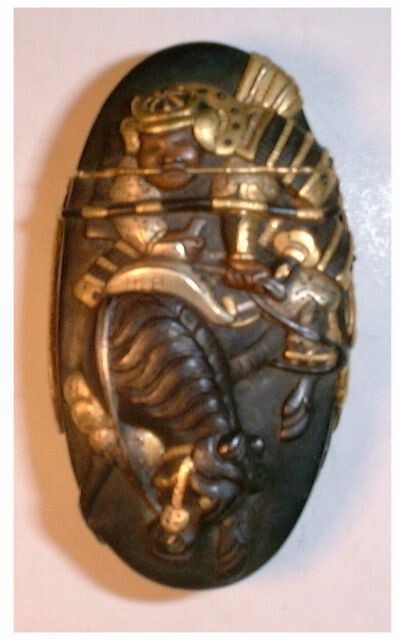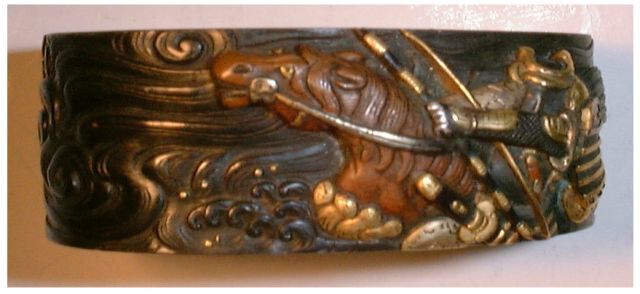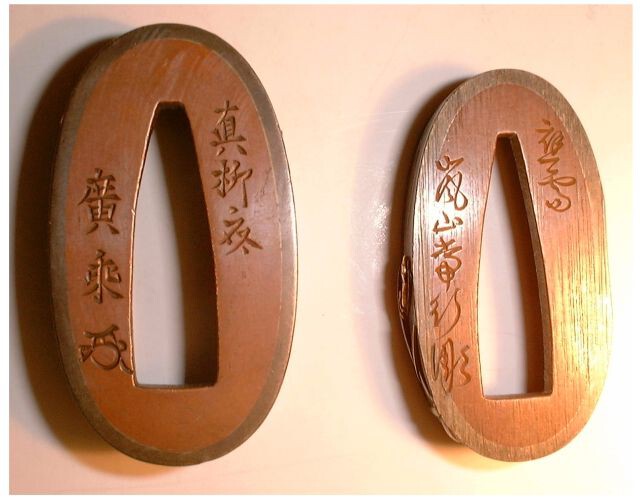-
Posts
815 -
Joined
-
Last visited
-
Days Won
1
Everything posted by docliss
-
Dear Eric, as a matter of interest, see http://www.antiqbook.com/boox/bos/77648.shtml It's a bit expensive, at $575.00, but .... Regards, John L.
-
Dear Eric Measurement of the image on the Klefisch catalogue suggests that the actual size of that tsuba is 6.9 cm - 5.85 cm; quite small for a katana tsuba, perhaps? John L.
-
Dear Eric This has developed into a fascinating series of posts, and the possibility obviously arises that the tsuba illustrated in the Klefisch catalogue was originally from the katana that Reinhard refers to, and thus a pair to your own. However, the measurements given in this catalogue are an unhelpful ‘H 6,9 cm – D 3,6 mm’, and I wonder if you have any more info regarding these? As an interested enquiry for general consideration, is it feasible that the artist of a daishÅ pair of tsuba might sign that for the daitÅ and not that for the shotÅ? Regards, John L.
-
Dear Eric Thank you for the additional information re the tsuba — the catalogue illustration is, indeed, of a tsuba almost identical to your own. Haynes lists Kiunsai Yasukuni as H 11166.0 in his Index of Japanese Sword Fittings and Associated Artists. This artist was working in Mito in the mid-1800s and was a student of Nukagawa Yasunori. You note that you have the Bauer catalogue in your possession, and he is listed therein on p. 442, # 670, D1115, text p. 98. Your photographs of the fuchi-gashira are rather dark to see much detail and, if the work of Hamano Kaneyuki (H 02616.0), are indeed to be treasured. The second son of Hamano ShÅzui, he succeeded as the second master of the Hamano school from 1770-1776. Haynes does, however, list a second artist using the same kanji and working in the 1800s. In all, a beautiful set. Regards, John L.
-
Dear Eric I think that the point of Reinhard’s message was to encourage you to commit yourself to some judgement as to your tsuba’s provenance, rather than to just let somebody else do all of the work for you. We are all of us — albeit some more than others — on a learning curve. That said, your tsuba is for a shotŠand, judging by the worn, silver areas on the seppa-dai, is constructed of a darkly patinated shibuichi. It depicts a naturalistic image of an oak tree, its trunk, branches and leaves in takabori. There are ivy tendrils and leaves in shibuichi and gold, and a dragonfly in a high relief iroye of copper. The flashiness of the image, and the resection of an upper part of the seppa-dai to accomodate a branch of the tree suggest late Edo work. Both the MitŠand the Hamano schools are possible sources, but the vulgarity of the work and the rather unsympathetic treatment of the insect are uncharacteristic of good Hamano work. One of the MitŠschools then, but demonstrating a Hamano influence .... The MitŠYegawa school worked largely in the soft-metal alloys, displaying both Nara and Hamano influences, and this is a possible provenance for your tsuba. In order to identify a maker one would need to know of a comparable tsuba with either a mei or a reliable attribution and, sadly, I do not know of one. Therefore, to summarise, it is a C19 wakizashi tsuba, possibly by a competent, but not outstanding, artist of the MitŠYegawa school. I, like you, share that learning curve, and it is quite probable that another member, more knowledgeable than I, will disagree with this opinion. But, unlike you, I have at least made a commitment. Regards, John L.
-
As an addendum to John’s recent posting about this tsuba, there appears to be considerable confusion in the literature regarding Morikawa Masakage (H 04059.0) and Tanaka Masakage (H 04060.0), and Wakayama does not clarify the relationship between them or if, indeed, they are the same artist. John gives the details of the former artist, a student of Tanaka Kiyotoshi, T. Toshikage and T. Yoshikage and supposedly the best of the late Tanaka artists. But I do not personally think that Jeff’s tsuba is the quality of this artist’s work — the outline of the raised mimi is very unhappy; I am not convinced by the suggestion of original kuchi-beni, as favoured by this artist; and I have some reservations about the kao. Perhaps John will agree that this is more likely to be the work of the second artist listed above? Regards, John L.
-
Dear Milt A very nice, SÅtenesque pair of fuchi-gashira, inscribed Yanagawa Naomasa with kao. Comparing the kao with those in KinkÅ Meikan, pp. 311a-d and 312a-b, I’m not too sure that they are pukka, but you probably weren’t expecting that anyway! Regards, John L.
-
Dear John It is obviously not possible to make a firm attribution on your recently acquired tsuba, and we look forward to seeing it in better detail in the near future. I wonder, however, if it is one of that rather enigmatic group that Gemmell labelled as ‘Large Figure SÅtens’, and described as ‘incorporating only two or three full-length figures filling the whole extent of the frame ....’ Regards, John L.
-
Dear Mark The inscription on you tsuba reads, I think, SOHEISHI NYUDO SOTEN SEI. Sadly, this is not SÅten work, but is one of many, poor quality copies of Hikone-bori that were produced by the Aizu ShÅami workers in the second half of the C19. You will find several, recent references to this type of work in past postings to this message board. Regards, John L.
-
Sadly I do not have a tsuba by ItÅ Masakatsu (H 04085.0), but have posted an image of a mumei, Edo ItÅ tsuba that demonstrates marked similarities to the one Max posted. Like Max’s, the left-hand side of the tsuba — depicting the wall of a tea house with rustic supports — is solid plate, while the left-hand side depicts flowers — and, in this case, tea ceremony utensils — in openwork. The form of the seppa-dai and of the ryÅ-hitsu is also similar in both. It is accepted that the openwork on this tsuba is much more sophisticated; it has no soft-metal decoration; and, of course, it has the decorative rim that is lacking in Max’s. But I suggest that these differences simply reflect the later date of the second tsuba. Regards, John L.
-
Dear Stephen Sadly I have to agree with John - the work on the fuchi-gashira is not of the quality of that of the Omori school. The tsuba .... Are those not parts of a horse's bit? And yes - probably Higo work. The kodzuka is very ordinary Meiji work, of the type of which which one sees quite a lot . But could not the loss of colouring on the right-hand bird be due, simply, to increased exposure to friction of an indifferent patination? Regards, John L.
-
Lee might be interested to see the attached image. Sadly, it is not a 'Jingo tsuba', but is of a similar dragon theme and illustrates well, I think, what a 'strong Jingo influence' can look like. Regards, John L.
-
Dear John, in common with both you and Richard, I too would have instinctively labelled Lee's tsuba as late Edo, Aizu Shoami or Mito work. As I am sure that you are aware, tsuba with dragons weaving their way in and out through the hira are ubiquitous, but the one you linked us to on Ricecracker.com is a completely different story. It is superb Jingo work, with the dragon rendered entirely in silver inlay although oxidation makes it difficult to appreciate the impact of this. John L.
-
Also, perhaps John could expand on his statement 'Certainly a copy of Jingo work', since I, personally, have difficulty in identifying this. The attached image is of a similar tsuba presently on eBay. John L.
-
Congratulations, Martin, on your very attractive web site. I shall certainly add it to my 'must look regularly' list. John L.
-
Thanks for that, John. Yes indeed, there was a typo there which I have corrected - I hope that it is OK now? John.
-
Dear Kevin Brian has given you some excellent references to Nara work, but your questions about the fuchi-gashira that you posted have remained unanswered, and unanswered posts offend me! Founded in the early C17, the early work of the school was of soft-metal incrustation on an iron ground. This KÅ-Nara work , since it was widely copied and generally unsigned, is generally recognised as a style of tsuba rather than as the product of a particular group of artists. But by the end of the century Yasuchika, after studying under Nara Tokimasa, had introduced a change in style that was the forerunner of Nara kinkÅ work. The use of both iron and any of the soft-metal alloys as a base, and a wide range of techniques and styles, makes it very difficult to define a ‘Nara style’. This difficulty is further compounded by the existence of Sugiura Joi, Nara Toshinaga and Hamano ShÅzui, who together with Tsuchiya Yasuchika, form the Nara Sansaku. Each of these artists founded his own school with its own distinctive styles. In general, however, Nara kinkÅ work is characterised by the depiction of a wide-ranging variety of themes, variously interpreted and often featuring exquite iroye of the soft metals. While beautifully rendered, these never appear flashy or contrived, and give the impression of quiet, good taste. Your own tsuba has none of these qualities. In that the kashira features shishiai-bori, and the fuchi katakiri-bori, it could be said to be in the ‘Joi style’ but, sadly, is a very poor attempt at this. I hope that this answers some of your queries? Regards, John L.
-
Might this not be the work of Goto Mitsumori (H 05275.0), a student of Goto Seijo? It is not that of Goto Keijo, who also used the Mitsumori name, whose mei and kao in Kinko Meikan are quite different from the pair posted. Regards, John L.
-
Further to the images that I posted of the Hamano fuchi-gashira, are any of you eagle-eyed experts able to identify the tiny kanji that are engraved on the pommel of the horse on the kashira? I have enlarged and clarified them as well as I can, but they are very difficult to make out. Any suggestions ...? With thanks, John.
-
This is, presumably, an image of a legend from the Wars of the Gempei, with Kajiwara Kagesue and Sasaki no ShirŠTakatsuna fording the Uji river. Kagesue rides Surusumi, one of Yoshitsune’s own horses, and Takatsune rides Ikezuki, belonging to Yoritomo. Takatsuna calls after Kagesue to tighten his horse’s girth which, holding his bow in his mouth, he does, thus being beaten to the opposite bank. The bow in the water in Ford’s image represents this incident. In most representations of this legend Ibezuki is depicted as being bay in colour, but I know of no reason for this convention. Perhaps Brian is correct in his statement regarding ‘first impressions’, and the detail on Ford’s tsuba is not so good. By way of contrast, I have posted images of a mumei pair of Hamano fuchi-gashira depicting the same incident. Kagesue, on the kashira, is mounted on a wonderfully foreshortened horse. His bow in his mouth, he is seen to be tightening his girth with his left hand, his leg being turned out to facilitate this. Takasuna is shown in beautiful detail on the fuchi. I must confess to being a little worried by what Ford tells us about this tsuba. Regards, John L. PS May I take issue with Ford over his statement that water drops are usually silver - surely this is not so?
-
I am obviously very impressed by Ford’s Hikone-bori tsuba, but why has John labelled it a ‘KenjÅ tsuba’? He is not using this term in its narrower sense (from the shop of JÅ«ichiya in KyÅto in the mid-1600s) surely. Perhaps he means simply ‘given as a gift’, but what basis has he for saying this, apart from the fact that anybody would obviously be delighted to receive it? The decorative nature of the sekigane; the absence of any noticeable sign of wear; and the extension of the tachi blade onto the seppa-dai might all, perhaps, suggest late Edo or Meiji work that was never intended for mounting. ? C19 Mito work. Thank you, Ford, for posting it. John L.
-
Thank you Ford - we are getting there gradually. Regards, John.
-
Thank you very much, Ludolf, for your help. I am most grateful. Regards, John.
-
Might I crave assistance with the mei on two new fuchi? The first would appear to be simple, but I am having problems with the recognition of the fourth kanji. My difficulty with the second is, I suspect, self-evident! With grateful thanks for your help, John L.
-
Dear Michal In a purely personal reply to your query, the dictionary definition of a circle is ‘a plane figure bounded by one line every point of which is equally distant from a fixed point called the centre’. Thus I suppose that, by this definition, a tsuba is no longer maru-gata if there is any difference between its width and length — even if this difference is minimal it must then be considered to be elliptical. I can admit to a certain logic in classifying the form of a tsuba by naked eye impression, and this has the additional bonus of possibly acknowledging the tsubakÅ’s original intentions. But I personally prefer the consistency produced by actual measurement. Regards, John L.





